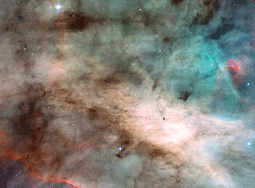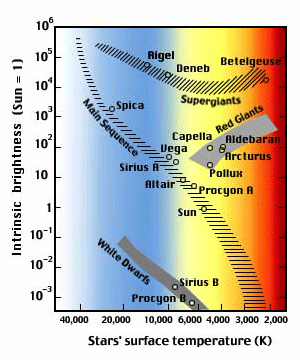Introduc
Birth of Stars[4]
Although stars are inanimate objects, we tend to describe their stages of evolution as if they were alive. Just like us, they are born, live and then die. Of course, their lifetimes are much longer than ours and they can ‘live’ for billions of years. And during their lives, stars produce monumental amounts of energy through nuclear processes in their interior, giving them their characteristic shine. So let’s start at the beginning. Where do stars come from?
Matter is not distributed equally in space. In between the voids of emptiness, there are regions of gas and dust clouds, called the interstellar medium, which are denser than their surroundings. Usually, the kinetic energy of the clouds’ particles will be balanced by the gravitational force of the cloud. However, if the cloud is disturbed, perhaps by a nearby supernova, the balance is broken and the cloud may become denser in certain areas.
When they reach a certain critical mass, the densest parts of the cloud can contract under the influence of their own gravitational attraction, causing the cloud to fragment into smaller and denser sections. This process takes a few million years. As the cloud contracts, the temperature and the density increases. Eventually, the new object and gains a spherical shape and becomes what is called a protostar. Due to its gravitational pull, matter from the cloud still falls into it, continuously raising the temperature and density until they become so large that nuclear reactions start where the hydrogen fusions to make helium. A new star is born.

In the center of this gas and dust cloud called Omega nebula continuously new stars are formed. Source: NASA
Most stars are born within the arms of a spiral galaxy, where there is more gas and dust. Sometimes, several stars can form within the same molecular cloud, and we have what is known as a star cluster. There are two types of cluster; open clusters, which tend to contain a few hundred relatively young, hot stars that quite spaced out, and globular clusters, that tend to contain thousands of much older stars, more densely packed together.
Except the Sun, most stars are extremely far away. The nearest star, Proxima Centauri, is 4.24 light years away. This means that when astronomers observe stars, it’s difficult to see exactly what’s going on. They mainly observe two things: the luminosity of the star and its colour. When astronomers speak about the luminosity of a star, what they mean is the absolute magnitude, that is the real brightness of a star and not the apparent brightness that would depend on how far it is from us. This is normally measured on a logarithmic scale with respect to our Sun: for example, if a star has a luminosity of 1, then it has the same brightness as our Sun. The colour of a star is related to its surface temperature: 'hotter' stars appear to be bluer than colder stars, which are reddish.

One can create a 2-dimensional plot with the stars' surface temperatures versus their luminosity. The plot could look like the one here on the right. This is probably the most important diagram in astronomy, the Hertzsprung-Russell diagram, named after the two astronomers that first drew it. On the horizontal axis is the surface temperature increasing from right to left, and on the vertical axis is the energy output or luminosity of the star.
Interestingly, the stars on the Hertzsprung-Russell diagram are not distributed evenly. Instead, they form a very distinct pattern. Most of the stars lie on a band from the top left of the diagram (large, bright, hot stars) to the bottom right (small, dim, cool stars). This is called the Main Sequence. At the top right of the diagram are very large, bright but cool stars which we call Red Giants and at the bottom left corner are the White Dwarfs, small, dim, but extremely hot stars.